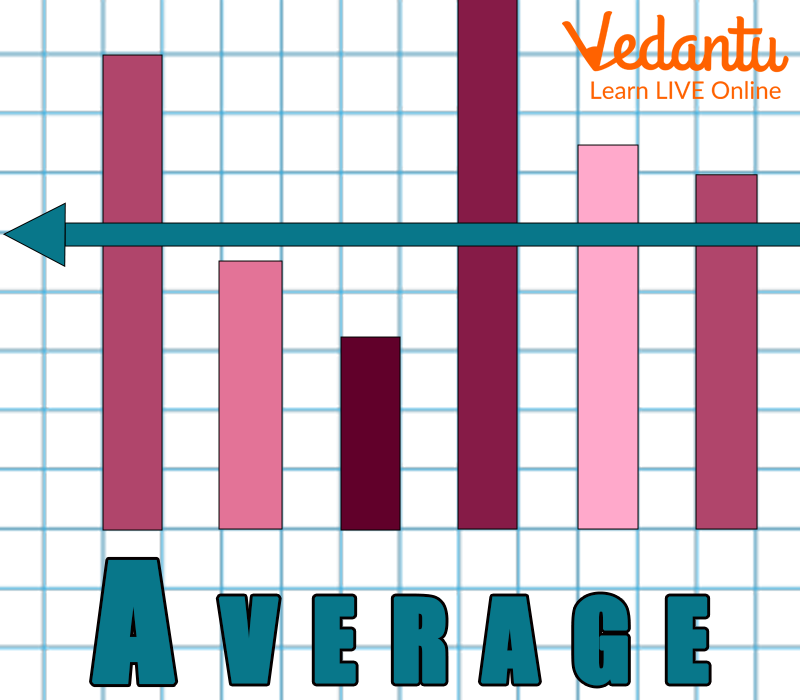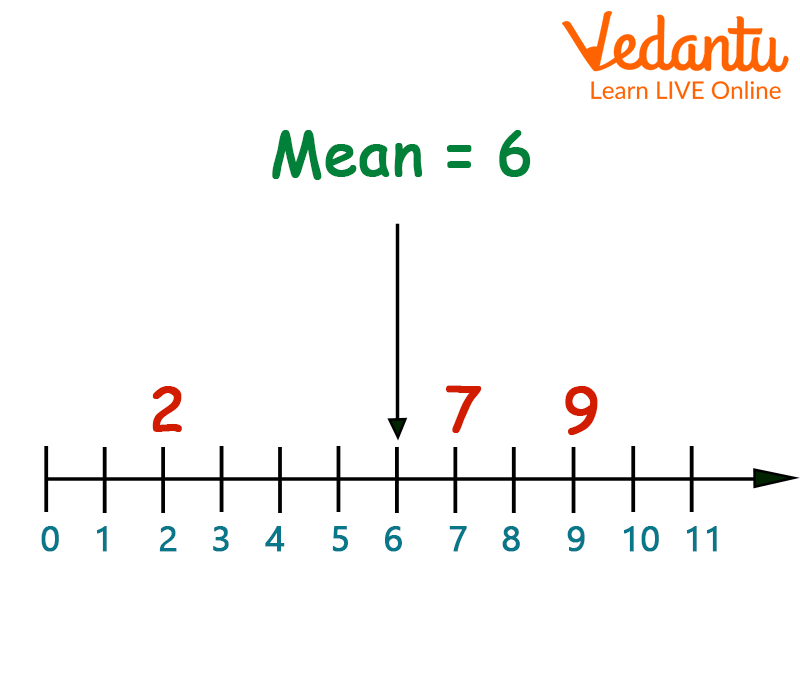




How to Calculate Average: Step-by-Step Guide for Students
An average is a number that is selected to represent a list of numbers in everyday life; it is frequently the sum of the numbers divided by the number of numbers in the list the arithmetic mean. For example, 5 is the average of the numbers 2, 3, 4, 7, and 9, which add up to 25. Depending on the circumstance, an average could also be another statistic like the median or mode.
What is Average in Math:
The mean value, which is the definition of the average, is the ratio of the sum of the values in a certain set to all of the values in the set. The average is essentially the mean of the variables that are represented by x. It is also denoted by the sign "μ".

Average
Formula of Average in Maths:
It is fairly simple to calculate the average of a set of numbers or values. The only thing left to do is to add up all the numbers and divide the total by the number of values provided. As a result, the following is the average formula with example:
Average: Sum of Values obtained/ Total Number of Values
Assume that we have provided n different values, such as \[{\rm{x_1}}\],\[{\rm{x_2}}\] ,\[{\rm{x_3}}\]………\[{\rm{x_a}}\].
Following data will have the average as:
Average equals \[\frac{{[{\rm{x_1}} + {\rm{x_2}}...... + {\rm{x_a]}}}}{{\rm{a}}}\]
How to Calculate Average in Maths?
Find Sum of Numbers in Step 1:
Finding the total of all the given numbers is the first step in calculating the average of a set of numbers.
Find Number of observations in Step 2:
The next step is to determine how many numbers are there in the dataset.
Calculating the Average in Step 3:
In order to arrive at the average, divide the total by the number of observations.

Average of 2,7,9.
Solved Average Examples:
Example 1: In a group of men with heights of 5.5, 5.3, 5.7, 5.9, 6, 5.10, 5.8, 5.6, 5.4, and 6. then measure the average height.
Ans:
Men's heights are as follows: 5.5, 5.3, 5.7, 5.9, 6, 5.10, 5.8, 5.6, 5.4, and 6.
Average is calculated as the sum of all males' heights divided by the total number of males.
A \[ = \frac{{[5.5 + 5.3 + 5.7 + 5.9 + 6 + 5.10 + 5.8 + 5.6 + 5.4 + 6]}}{{10}}\]
A \[ = \frac{{5.63}}{{10}}\]
A \[ = 5.63\]
Therefore , the average height is 5.63 units.
Example 2: If a team of nine students has members that are 12, 13, 11, 12, 13, 12, 11, 12, 12 Then determine the team's average student age.
Ans:
Given that kids range in age from 12, 13, 11, 12, 13, 12, 11, and 12,
Average: Students' combined ages divided by the total number of students
A \[ = \frac{{[12 + 13 + 11 + 12 + 13 + 12 + 11 + 12 + 12]}}{9}\]
A \[ = \frac{{108}}{9}\]
A \[ = 12\]
Consequently, a team's average age of students is 12 years old.
Example 3: Find the average of the first ten natural numbers.
Ans: As we know, the first ten natural numbers are 1,2,3,4,5,6,7,8,9,10.
Average \[ = \frac{{1 + 2 + 3 + 4 + 5 + 6 + 7 + 8 + 9 + 10}}{{10}}\]
\[ = \frac{{55}}{{10}}\]
\[ = 5.5\]
Thus,Average \[ = 5.5\]
Conclusion
We have seen the average chapter in maths. The mean value, which is the definition of the average, is the ratio of the sum of the values in a certain set to all of the values in the set.In everyday life, a single number is chosen to stand in for a group of other numbers.
FAQs on Average in Maths: Concept, Formula & Examples
1. What is the concept of 'average' in Maths? Please provide an example.
The average is a single number that represents the central or typical value of a set of numbers. It provides a summary of the entire dataset in one representative value. For example, to find the average of the numbers 2, 4, and 9, you first add them together (2 + 4 + 9 = 15) and then divide by the count of numbers in the set (which is 3). The average is 15 ÷ 3 = 5.
2. What is the formula to calculate the average of a set of numbers?
The formula to calculate the average, which is also known as the arithmetic mean, is straightforward. You sum up all the observations or values in the dataset and then divide by the total number of observations. The formula is: Average = (Sum of all observations) / (Total number of observations).
3. Why is understanding the average important in our daily lives?
Understanding the concept of average is crucial because it helps us make sense of large amounts of information and make informed decisions. For instance:
- In school, your average grade gives you a single measure of your overall academic performance.
- In cricket, a batsman's batting average indicates their typical scoring performance over many matches.
- Weather forecasts often mention the average temperature for a month, helping us understand the typical climate of a place.
4. Are the terms 'average' and 'mean' the same in mathematics?
Yes, in the context of the CBSE/NCERT syllabus and general mathematics, the term 'average' almost always refers to the 'arithmetic mean'. While there are other types of averages in advanced statistics, for most practical purposes, 'average' and 'mean' can be used interchangeably. Both are found by summing the values and dividing by the count of values.
5. How is the average different from the median and the mode?
While all three—average (mean), median, and mode—are measures of central tendency, they describe the 'centre' of the data in different ways:
- The Average (Mean) is the sum of all values divided by the number of values. It is affected by every number in the dataset.
- The Median is the middle value in a dataset that has been arranged in numerical order. It is less affected by extremely high or low values.
- The Mode is the value that appears most frequently in a dataset. A set of data can have one mode, more than one, or no mode at all.
6. Can the average of a set of numbers be a value that is not part of the original set?
Yes, absolutely. The average is a calculated value and does not have to be one of the numbers in the original dataset. For example, the average of the numbers 4 and 6 is (4 + 6) / 2 = 5. The number 5 is the average, but it was not present in the original set {4, 6}. This demonstrates that the average represents a central point, which can fall between the given data points.
7. How does a very high or very low number (an outlier) impact the average of a dataset?
A very high or very low number, known as an outlier, can significantly distort the average. Because the average calculation uses every single value, an outlier pulls the average towards its extreme value. For example, in the set {5, 6, 7, 100}, the average is 29.5. This value is not a good representation of the typical numbers in the set, as it has been heavily influenced by the outlier, 100. This is a key reason why the median is sometimes preferred over the mean.
8. Where is the concept of average used outside of Maths textbooks?
The concept of average is used extensively in many real-world fields beyond the classroom. For example:
- Economics: To calculate average income, average price changes (inflation), or average crop yield per hectare.
- Sports: To determine a player's average score, goals, or runs per game.
- Science: To find the average result from multiple experimental trials to ensure accuracy.
- Business: To calculate average daily sales, average customer ratings, or average product delivery time.
9. What does the average value truly represent for a group of numbers?
The average value represents a point of balance or a central tendency for a group of numbers. You can think of it as the value that all numbers in the set would be if the total amount were distributed equally among them. For instance, if the average score of a team is 20, it implies that if the total score were shared evenly among all players, each would have scored 20. It provides a single, representative value that summarises the entire dataset.















